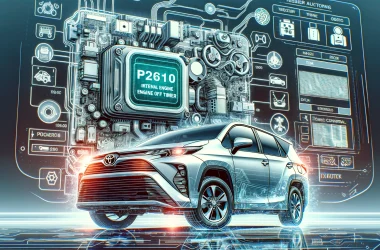In the labyrinthine realm of automotive diagnostics, there exists a mystifying language composed of alphanumeric codes that perplex even the most seasoned enthusiasts. Today, we set our sights on unveiling the enigmatic P1870 code, which has cast a shadow of uncertainty over countless Chevy owners. As the engine light ominously glows, fear not, for within the depths of this automotive conundrum lies an opportunity to understand, resolve, and conquer. In this article, we embark on a journey of unraveling the secrets behind the P1870 code, demystifying its significance, and arming you with the knowledge to tackle this Chevy puzzle head-on. Reset your doubts, engage your curiosity, and step into the realm of the unknown as we delve into the intricacies of the P1870 code to bring clarity to those misled by its obscure presence.
Understanding the P1870 Code in Chevy Vehicles
Have you ever encountered the mysterious P1870 code in your Chevy vehicle and wondered what it meant? Don’t worry, we’ve got you covered! Here, we’ll help you unravel the secrets behind this perplexing code, giving you a deeper understanding of what it signifies and how it affects your vehicle’s performance.
First and foremost, the P1870 code in Chevy vehicles is directly related to the transmission system. It indicates a problem with the Transmission Control Module (TCM) and specifically refers to a transmission slipping condition. When this code appears, it means that your vehicle’s TCM has detected excessive slippage during gear shifts, leading to a decreased overall performance and potentially causing further damage if left unaddressed.
Key points to consider about the P1870 code:
- Transmission slipping: The P1870 code signifies that your Chevy vehicle’s transmission is experiencing slipping during gear shifts, impacting its ability to smoothly transition between gears.
- Effects on performance: With the P1870 code present, you may experience erratic shifting, decreased fuel efficiency, a loss of power, or even a complete inability to accelerate properly.
- Potential causes: The code can be triggered by various factors such as wear and tear on transmission components, hydraulic pressure issues, faulty solenoids, or even a malfunctioning TCM.
- Seek professional assistance: It is highly recommended to consult a qualified mechanic or dealership to diagnose and resolve the issue associated with the P1870 code, as it requires expertise in transmission systems.
By understanding the P1870 code’s implications and seeking prompt assistance, you can nip any potential transmission problems in the bud and ensure your Chevy vehicle continues to run smoothly on the open road.
Common Causes of the P1870 Code in Chevy Vehicles
In Chevy vehicles, the P1870 code is a common issue that can arise, causing drivers to be on high alert. This code typically indicates a problem with the Transmission Component Slipping, and there are a few common causes behind it that can be addressed.
One possible cause of the P1870 code is a faulty torque converter clutch solenoid. This solenoid is responsible for engaging and disengaging the torque converter clutch, which helps with smooth shifting. If the solenoid is malfunctioning, it can lead to a slipping transmission and trigger the P1870 code. Another possible culprit is a worn or damaged valve body. The valve body controls the flow of hydraulic fluid in the transmission, and if it becomes worn or damaged, it can cause erratic shifting and trigger the P1870 code. Additionally, low transmission fluid or a clogged transmission filter can contribute to the code being displayed.
Diagnostic Steps to Resolve the P1870 Code in Chevy Vehicles
When encountering the frustrating P1870 code in your Chevy vehicle, fear not, for there are a few diagnostic steps that could help resolve the issue. Follow these steps below:
- Inspect Transmission Fluid: Start by checking the transmission fluid level and condition. Low fluid levels or dirty fluid can cause erratic shifting and trigger the P1870 code. If the fluid is low, simply add the recommended type until it reaches the appropriate level. In case the fluid appears heavily contaminated or burnt, consider replacing it following the manufacturer’s guidelines.
- Scan for Additional Trouble Codes: Connect an OBD-II scanner to your vehicle’s diagnostic port and scan for any additional trouble codes present. Sometimes, other codes may be stored alongside the P1870 code, providing valuable insights into related issues. Addressing these additional codes can often resolve the underlying problem causing the P1870 code.
Continuing with the diagnostic steps:
- Inspect Wiring and Connections: Inspect the wiring harnesses and connectors around the transmission for any signs of damage, loose connections, or corrosion. Faulty wiring can lead to poor communication between transmission components, resulting in the P1870 code. Repair or replace any damaged or loose wires and ensure all connections are clean and secure.
- Perform a Thorough Transmission System Check: Conduct a comprehensive inspection of the transmission system, including sensors, solenoids, and valves. Check for any faulty components that might affect the proper functioning of the transmission. Replace or repair any defective parts as necessary, following the manufacturer’s recommendations.
By diligently following these diagnostic steps, you increase your chances of successfully resolving the P1870 code in your Chevy vehicle. However, should the issue persist, it is advisable to seek the assistance of a professional mechanic or authorized dealership to thoroughly diagnose and repair the underlying problem.
Expert Recommendations to Prevent
or Address the P1870 Code in Chevy Vehicles
When it comes to dealing with the dreaded P1870 code in your beloved Chevy vehicle, our team of experts has got you covered. We understand the frustration that arises when confronted with this pesky issue, but fear not, there are steps you can take to prevent or address it head-on.
Regular Maintenance: To prevent the P1870 code from rearing its ugly head, it is crucial to stay on top of regular maintenance. Make sure to follow the manufacturer’s recommended service intervals and keep up with routine tasks such as oil changes, filter replacements, and transmission fluid flushes. Neglecting these essential maintenance procedures can contribute to the occurrence of the P1870 code, so don’t skip out on them!
Check Transmission Fluid Levels: Low transmission fluid levels can be a significant culprit behind the P1870 code. Regularly check the fluid levels in your Chevy vehicle’s transmission using the dipstick provided. If you notice a decline in levels, it is essential to top it up promptly. Additionally, keep an eye out for any signs of fluid leakage, which might indicate a more significant underlying issue.
Q&A
Q: What is the P1870 code in Chevy vehicles?
A: The P1870 code is a diagnostic trouble code that specifically relates to transmission issues in Chevy vehicles.
Q: What does the P1870 code indicate?
A: The P1870 code usually indicates a problem with the transmission’s torque converter clutch (TCC) system.
Q: How does the torque converter clutch system work?
A: The torque converter clutch system is designed to lock up the torque converter at certain speeds to improve fuel efficiency and reduce transmission heat buildup.
Q: What are the common symptoms of the P1870 code?
A: Common symptoms of the P1870 code may include poor shift quality, hesitation or slipping during gear changes, and an illuminated Check Engine Light.
Q: Can the P1870 code impact the vehicle’s drivability?
A: In some cases, the P1870 code can affect the vehicle’s drivability and performance, especially during shifts, leading to a less smooth and efficient driving experience.
Q: What are the potential causes of the P1870 code?
A: Several factors can trigger the P1870 code, including a faulty torque converter clutch solenoid, a malfunctioning TCC PWM (Pulse Width Modulation) solenoid, a damaged torque converter, or low transmission fluid.
Q: How can I diagnose the P1870 code in my Chevy vehicle?
A: Proper diagnosis of the P1870 code requires a scan tool that can read transmission codes, as well as conducting a thorough inspection of the torque converter clutch system and related components.
Q: Is it safe to drive with the P1870 code?
A: It is generally recommended to address the P1870 code promptly to avoid potential long-term damage to the transmission. It is advisable to consult a qualified mechanic who can assess the severity of the issue and advise on whether it is safe to drive the vehicle.
Q: How can the P1870 code be repaired?
A: The repair process for the P1870 code will depend on the specific cause. It may involve replacing or repairing the torque converter clutch solenoid, TCC PWM solenoid, torque converter, or addressing any other underlying issues found during the diagnostics.
Q: Can I fix the P1870 code myself?
A: Fixing the P1870 code requires a certain level of mechanical expertise and specialized tools. It is recommended to consult a professional mechanic to accurately diagnose and repair the issue unless you have advanced knowledge and experience working on transmission systems.
Q: Are there any preventive measures to avoid the P1870 code?
A: Regular maintenance, such as checking and changing transmission fluid at recommended intervals, can help prevent the P1870 code. Addressing any performance or shifting issues promptly and keeping up with routine inspections can also help identify potential problems before they worsen.
Q: Does the P1870 code affect all Chevy models?
A: The P1870 code can potentially occur in various Chevrolet models, including trucks, SUVs, and sedans. However, it is essential to refer to the specific service manual or contact a mechanic to determine if your particular vehicle is susceptible to this code.
Concluding Remarks
As we wrap up our exploration of the elusive p1870 code in Chevy vehicles, we hope to have shed some light on this mysterious automotive enigma. From deciphering the cryptic digits to examining the potential causes, we’ve embarked on a quest to demystify this elusive error. While it may seem like a daunting hurdle for Chevy owners, fear not, for knowledge is power.
By equipping ourselves with the understanding of what the p1870 code symbolizes, we have begun a journey towards conquering the unknown. The neutral tone of this article aimed to present the facts without bias, guiding our readers towards plausible resolutions. We navigated through a sea of possibilities, exploring transmission malfunctions, torque converter dilemmas, and even the occasional wiring hiccup.
As we conclude this piece, we encourage you to approach the p1870 code with a sense of curiosity and determination. It may be a riddle that only your trustworthy mechanic can solve, but armed with information, you can become an active participant in this automotive puzzle. Remember, the journey towards a resolution is often as valuable as the destination.
So, fellow Chevy enthusiasts, may you face the p1870 code with an inventive spirit, an open mind, and a passion for unravelling automotive enigmas. Together, we shall conquer this code, turning a frustrating obstacle into an opportunity for growth and discovery. Safe travels on your Chevrolet journey, and may the road ahead be paved with fruitful solutions and smooth transmissions!

A Boston University Electrical Engineering graduate.
Electronics designer for EV giants like Tesla, BMW, VW, and Ford.
Enthusiastic Wikipedia moderator in the automotive category and author of automotive articles.
Passionate about tech, travel, and cars.





